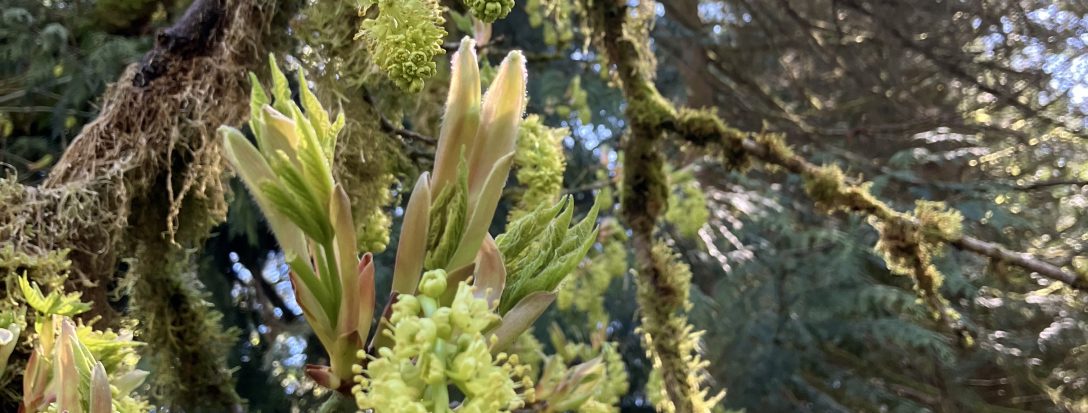Forest Stewardship is the name of the game here at Leafhopper Farm. Regenerative agriculture plays an important role in bringing back intact canopy of our keystone ecological system here in Western Washington- The Temperate Rainforest. Clear-cutting the landscape, especially in hill country, where the soil is more vulnerable to erosion because of slope, covering and retaining topsoil is most effectively done in these topographies with trees. It’s why any good hill farmer in Western Washington using livestock should be invested in silvopasture.
Here at EEC, the logging industry deforested this hillside multiple times, then 9.8 acres was subdivided out of a 160 acre parcel, and a homestead was born. By then, in the 1970s, elk were gone from the hillsides. The old forests, which had witnessed thousands of years, disappeared overnight in an horrific act of manifest destiny. With the protective canopy gone, rainy climate and sloped terrain in the foothills of The Cascades created erosion as soils washed down into rivers and out into the sound leaving degraded land cleared for agriculture. Pastures were established, and a few acres of forest somehow managed to naturally reseed and mature. Now, a generation later, fertility is starting to rebuild as the reintroduction of understory in shrubs and ground cover helps support the forests return to old growth. The sheep are also slowly removed from areas of the land as new forests are established. We’re planting in from the edges in most areas. There is a replanted maple and oak forest marked below on our land map. That and our CREP project in Weiss Creek are two officially replanted forests on the property.

This map shows the major part of our livestock rotational grazing area. There are two main paddock systems that are fully fenced, and we sub-divide those areas into smaller paddocks using portable electric mesh fencing. This is enough grazing for our flock of 13, and has supported seasonal grazing of up to double that number, with winter feeding almost exclusively on imported alfalfa.
The yellow area is out most recent replanting of maple, oak, and pine. It’s fenced to keep sheep out. We put our rams in there for short stints to eat up the blackberry and grass. The unmarked area to the left of the yellow area is the rest of that grazing paddock, consisting of three pasture spaces in about two acres.
The red area is out CREP planting, and no livestock systems can happen here. We move the sheep through on a road crossing a bridge over Weiss Creek, a salmon bearing stream, to access the back pasture south of the red CREP area. Much of this 2.5 acres has been replanted with native plants and continues to remain protected as restoration space and active wildlife corridor. This habitat remains the most divers and ecologically sound landscape at EEC Forest Stewardship.
This area of EEC is not commercially productive, but could be utilized as a foraging area for materials, medicine, food, and some animal forage- if we cut it and take it to the animals outside the CREP space. We also have permission to plant any other non-invasive species in the area, encouraging more diversity.
In the back pasture, we have established a nut grove comprised mostly of grafted chestnut verities planted in 2017, from Washington Chestnut Company. We plan to implement another planting in the fall of 2022. This fenced pasture is our largest at 3 acres. We can sub-divide the space into eight smaller pastures using portable electric mesh fencing.
The green highlighted area is about 1 acre. As the nut trees establish, creating good deciduous canopy, we’ll fill in with understory species of other food plants with a focus on native verities when possible. With climate change causing much dryer periods of time, many of the temperate rainforest species will struggle to survive, so EEC plans to introduce species capable of adapting to the fast changing times.
Our Cascade Katahdin Sheep are a perfect breed of browsing and grazing sheep to work in the many layered heights of vegetation. They are also adaptable to changing temperatures from scorching summers on the east side of Washington, where this flock started, to the bitter cold winters in Maine, where the Katahdin breed originated. Our flock has thrived in the wooded hillside environment through all the seasons now for going on four years, and EEC has been working with sheep on the land since 2013. In that time we’ve also established many new tree groves with understory natives, and continue to plant in from the edges with more forest and hedge to restore protection and stability to the landscape.
Fruit Orchards also play a role in our vision for the land here at EEC Forest Stewardship. Not all the forest we’re planting is native, some excellent domestic fruit trees are establishing, some of which are putting out fruit for the first time this year. It’s always encouraging to see fruit on a tree you planted- and a special shout out to my Mother for purchasing these trees. The grove is named in her honor. What these trees are in need of is ground cover companions. We’ve got a plan for that, and it has taken a few years of budgeting and some climate change revamping of species selection to better adapt to the hotter summers we’re expecting in future. We’ll also be replacing a couple of fruit trees that have failed, as some verities do when you are establishing any grove of trees.


At this stage of cultivation, we’re still trying out different verities of apple, and pear. Russet varieties seem resilient to blights and insect damage, and that’s what they were developed for in the first place. There’s endless info out there on heritage fruit, and it’s a wintertime pleasure of mine to pour over historical records of these fast disappearing gems. I’m also always thinking about the native North American fruits that thrive in our region. The fruit and nut trees have to be fenced off from the livestock, and even native young trees need protection when establishing. Though the natives take off faster and need far less attention to reach healthy maturity. That’s a fact I’m always turning over in my head when I’m looking at agricultural crops vs. wild species. In the long term, trialing blackberry will win out over strawberries or raspberry cultivars.


So why are the sheep so important to establishing the forests? They brows and graze, turning the vegetation into nitrogen rich poop which they spread around at they eat in the perfect quantity to regenerate fertility in the soil and providing meat protein for our omnivore diet. As I’ve talked about in other writings, the sheep are taking the place of elk and deer who would have roamed these hillsides in vast numbers when the old growth still stood and wolves helped manage the herds. We’re a far cry from that intact ecosystem, so we have to offer substitutes and take advantage of gaps in regrowth to input diversity in species for additional food and medicine we humans seek sustenance from through cultivation, which can still go hand in hand with restoration too. This creates a more furtive ground for the trees to thrive, the animals to jive, and the people to survive in an ever changing environment.

